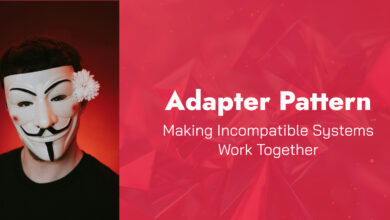The Magic of Facade Pattern: Making Messy Code Simple Again

The coffee was hot. The code was not. A mess of functions and calls scattered across the codebase like empty bottles after a long night. Too many systems. Too many connections. The program worked, but no one knew how.
The Facade pattern is your new best friend. Let me show you how to master it – no fluff, just the straight goods.
The Problem
You build software. It grows complex. Each new feature adds weight. Soon, what was once clean becomes tangled.
Look at this code:
function placeOrder(user, item, quantity) {
// Check user account
const userSystem = new UserSystem();
if (!userSystem.isActive(user.id)) {
return "Account inactive";
}
// Verify inventory
const stockSystem = new InventorySystem();
if (!stockSystem.checkStock(item.id, quantity)) {
return "Not enough in stock";
}
// Process payment
const paymentSystem = new PaymentSystem();
const paymentResult = paymentSystem.charge(user.paymentMethod, item.price * quantity);
if (!paymentResult.success) {
return "Payment failed";
}
// Update inventory
stockSystem.reduceStock(item.id, quantity);
// Create shipping label
const shippingSystem = new ShippingSystem();
const trackingCode = shippingSystem.createShipment(user.address, item, quantity);
// Send confirmation
const notificationSystem = new NotificationSystem();
notificationSystem.sendEmail(user.email, "Order Confirmation",
`Your order for ${quantity} ${item.name} has shipped. Tracking: ${trackingCode}`);
return "Order successful";
}Too many systems. Too many connections. Hard to read. Hard to change. Hard to fix.
The Solution: A Facade
A Facade is simple. It hides complexity. It gives one clean interface to many messy systems.
Here is the same code with a Facade:
class OrderFacade {
private userSystem = new UserSystem();
private stockSystem = new InventorySystem();
private paymentSystem = new PaymentSystem();
private shippingSystem = new ShippingSystem();
private notificationSystem = new NotificationSystem();
placeOrder(user, item, quantity) {
// All the same logic, but hidden inside the Facade
if (!this.userSystem.isActive(user.id)) {
return { success: false, message: "Account inactive" };
}
if (!this.stockSystem.checkStock(item.id, quantity)) {
return { success: false, message: "Not enough in stock" };
}
const paymentResult = this.paymentSystem.charge(
user.paymentMethod,
item.price * quantity
);
if (!paymentResult.success) {
return { success: false, message: "Payment failed" };
}
this.stockSystem.reduceStock(item.id, quantity);
const trackingCode = this.shippingSystem.createShipment(
user.address,
item,
quantity
);
this.notificationSystem.sendEmail(
user.email,
"Order Confirmation",
`Your order for ${quantity} ${item.name} has shipped. Tracking: ${trackingCode}`
);
return {
success: true,
message: "Order successful",
tracking: trackingCode
};
}
}Now the client code becomes clean:
// Clean. Simple. Direct.
const orderSystem = new OrderFacade();
const result = orderSystem.placeOrder(user, product, 3);
if (result.success) {
showSuccess(result.message);
} else {
showError(result.message);
}The complexity still exists. But it is hidden. Contained. Managed.
Real Life Examples
Facades are everywhere. Not just in code.
- A car’s dashboard is a Facade. It shows simple gauges. Behind them: complex engine systems.
- A restaurant menu is a Facade. It shows food options. Behind it: complex kitchen operations.
- A bank teller is a Facade. You make simple requests. Behind them: complex financial systems.
How To Build A Facade
- Find the complexity. Look for code that uses many systems.
- Create one class. This is your Facade.
- Move complexity inside. The Facade handles the details.
- Expose simple methods. They should be clear and direct.
- Replace old code. Use your new Facade instead.
When To Use A Facade
Use a Facade when:
- Your code talks to many systems
- You repeat the same steps often
- New team members struggle to understand the flow
- You need to change implementation details without changing client code
Facade Pattern in Real World
Authentication is complex. Users. Passwords. Tokens. Sessions. Security.
Without a Facade:
// Client code has to manage everything
function login(email, password) {
// Validate input
if (!email.includes('@') || password.length < 8) {
return "Invalid credentials";
}
// Find user
const db = new Database();
const user = db.findUserByEmail(email);
if (!user) {
return "User not found";
}
// Check password
const hasher = new PasswordHasher();
if (!hasher.compare(password, user.passwordHash)) {
return "Wrong password";
}
// Generate token
const tokenGen = new TokenGenerator();
const token = tokenGen.create(user.id);
// Save session
const sessionManager = new SessionManager();
sessionManager.createSession(user.id, token);
// Log activity
const logger = new ActivityLogger();
logger.log("login", user.id);
return token;
}With a Facade:
// A clean Facade
class AuthFacade {
private db = new Database();
private hasher = new PasswordHasher();
private tokenGen = new TokenGenerator();
private sessionManager = new SessionManager();
private logger = new ActivityLogger();
login(email, password) {
// Validate input
if (!email.includes('@') || password.length < 8) {
return { success: false, message: "Invalid credentials" };
}
// Find user
const user = this.db.findUserByEmail(email);
if (!user) {
return { success: false, message: "User not found" };
}
// Check password
if (!this.hasher.compare(password, user.passwordHash)) {
return { success: false, message: "Wrong password" };
}
// Generate token
const token = this.tokenGen.create(user.id);
// Save session
this.sessionManager.createSession(user.id, token);
// Log activity
this.logger.log("login", user.id);
return {
success: true,
token: token,
userId: user.id
};
}
}
// Clean client code
const auth = new AuthFacade();
const result = auth.login(email, password);
if (result.success) {
saveToken(result.token);
redirectToDashboard();
} else {
showLoginError(result.message);
}The details are hidden. The interface is clear.
Common Mistakes
- Too much responsibility. A Facade should coordinate systems, not add new logic.
- Too big. Create multiple Facades if needed, not one giant one.
- Too restrictive. Allow access to subsystems when advanced users need it.
Final Thoughts
Good code is like good writing. It should be clean. Direct. Purposeful. No extra words. No complexity where simplicity will do.
The Facade pattern brings simplicity to complex systems. It does not remove complexity. It manages it. Controls it. Hides it behind a clean interface.
Next time you face complex code that uses many systems, remember: a Facade can help. Create a simple interface. Hide the details. Make your code clear and direct.
The code will be better. The bugs will be fewer. The coffee will still be hot



